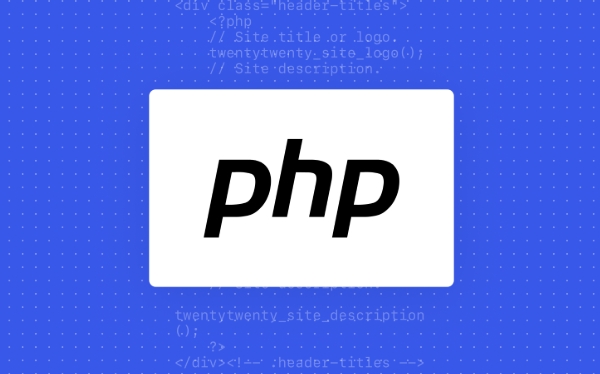PHP remains relevant today due to its dominance in content management systems and continuous modernization.1. It powers over 70% of known server-side websites, largely because of WordPress.2. PHP 8 introduced performance boosts and features like JIT compilation.3. It excels in CMS-driven sites via WordPress, Drupal, and Laravel.4. E-commerce platforms like WooCommerce and Magento rely on PHP.5. PHP is efficient for custom apps using frameworks like Laravel.6. It supports API development, though less trendy than Node.js.7. Alternatives like Node.js or Go may be better for real-time or cloud-native apps.8. To start or return to PHP, use Laravel, Composer, PHPUnit, and follow best practices.

PHP has been a foundational language in web development for decades, and while newer technologies have emerged, it still plays an important role—especially in areas like content management systems, e-commerce platforms, and server-side scripting.

Why PHP Is Still Relevant
Even though some developers consider PHP outdated, the truth is it powers over 70% of websites whose server-side language we know—mainly because of WordPress. That alone keeps PHP relevant. It's also continuously improving: PHP 8 brought significant performance boosts and modern features like JIT compilation and union types.
If you're maintaining or building a site that needs to integrate with WordPress, Drupal, or Laravel-based apps, PHP is still a solid choice. It's especially useful when you need something up and running quickly without reinventing the wheel.

Common Use Cases for PHP Today
- Content Management Systems (CMS): WordPress, Joomla, and Drupal are all built on PHP. If you're building a blog, business site, or news portal, these tools can save you a lot of time.
- E-commerce Platforms: WooCommerce, Magento, and OpenCart rely heavily on PHP. These are go-tos for online stores, especially when customization and plugin ecosystems matter.
- Custom Web Applications: With frameworks like Laravel and Symfony, developers can build scalable, secure applications faster than starting from scratch.
- API Development: While not as trendy as Node.js for APIs, PHP can still handle RESTful services efficiently, especially when integrated with modern frameworks.
These use cases show that PHP isn’t going away—it’s just shifted from being the default backend option to being a specialized tool where it still shines.
When You Might Choose Something Else
PHP might not be your best bet if you're building something highly interactive or real-time, like a chat app or live dashboard. In those cases, JavaScript-based stacks (like Node.js with React) offer better integration and real-time capabilities.

Also, if you're working on microservices or cloud-native applications, languages like Go, Python, or even Rust might be more suitable due to their performance characteristics and ecosystem support.
Still, for many small to mid-sized web projects, especially those relying on existing PHP-based tools, switching stacks might add complexity without clear benefits.
Getting Started (or Back into) PHP
If you're new or returning to PHP, here are a few tips:
- Start with a framework like Laravel—it gives structure and modern features out of the box.
- Learn how Composer works; it's PHP’s package manager and essential for managing dependencies.
- Get comfortable with tools like PHPUnit for testing and PHPStan for static analysis.
- Understand how to work with databases using PDO or Eloquent ORM.
- Practice writing clean, reusable code—PHP makes it easy to write messy scripts if you’re not careful.
The key is to treat PHP like any other modern language: follow best practices, use version control, and stay updated with new features.
Basically, PHP isn't the future of everything, but it's still doing a lot of heavy lifting on the web today.
The above is the detailed content of PHP's Role in Web Development. For more information, please follow other related articles on the PHP Chinese website!

Hot AI Tools

Undress AI Tool
Undress images for free

Undresser.AI Undress
AI-powered app for creating realistic nude photos

AI Clothes Remover
Online AI tool for removing clothes from photos.

Clothoff.io
AI clothes remover

Video Face Swap
Swap faces in any video effortlessly with our completely free AI face swap tool!

Hot Article

Hot Tools

Notepad++7.3.1
Easy-to-use and free code editor

SublimeText3 Chinese version
Chinese version, very easy to use

Zend Studio 13.0.1
Powerful PHP integrated development environment

Dreamweaver CS6
Visual web development tools

SublimeText3 Mac version
God-level code editing software (SublimeText3)

Hot Topics
 PHP 8 Installation Guide
Jul 16, 2025 am 03:41 AM
PHP 8 Installation Guide
Jul 16, 2025 am 03:41 AM
The steps to install PHP8 on Ubuntu are: 1. Update the software package list; 2. Install PHP8 and basic components; 3. Check the version to confirm that the installation is successful; 4. Install additional modules as needed. Windows users can download and decompress the ZIP package, then modify the configuration file, enable extensions, and add the path to environment variables. macOS users recommend using Homebrew to install, and perform steps such as adding tap, installing PHP8, setting the default version and verifying the version. Although the installation methods are different under different systems, the process is clear, so you can choose the right method according to the purpose.
 What is PHP and What is it Used For?
Jul 16, 2025 am 03:45 AM
What is PHP and What is it Used For?
Jul 16, 2025 am 03:45 AM
PHPisaserver-sidescriptinglanguageusedforwebdevelopment,especiallyfordynamicwebsitesandCMSplatformslikeWordPress.Itrunsontheserver,processesdata,interactswithdatabases,andsendsHTMLtobrowsers.Commonusesincludeuserauthentication,e-commerceplatforms,for
 Your First PHP Script: A Practical Introduction
Jul 16, 2025 am 03:42 AM
Your First PHP Script: A Practical Introduction
Jul 16, 2025 am 03:42 AM
How to start writing your first PHP script? First, set up the local development environment, install XAMPP/MAMP/LAMP, and use a text editor to understand the server's running principle. Secondly, create a file called hello.php, enter the basic code and run the test. Third, learn to use PHP and HTML to achieve dynamic content output. Finally, pay attention to common errors such as missing semicolons, citation issues, and file extension errors, and enable error reports for debugging.
 How Do You Handle File Operations (Reading/Writing) in PHP?
Jul 16, 2025 am 03:48 AM
How Do You Handle File Operations (Reading/Writing) in PHP?
Jul 16, 2025 am 03:48 AM
TohandlefileoperationsinPHP,useappropriatefunctionsandmodes.1.Toreadafile,usefile_get_contents()forsmallfilesorfgets()inaloopforline-by-lineprocessing.2.Towritetoafile,usefile_put_contents()forsimplewritesorappendingwiththeFILE_APPENDflag,orfwrite()w
 Advanced Java Security Manager Configuration
Jul 16, 2025 am 01:59 AM
Advanced Java Security Manager Configuration
Jul 16, 2025 am 01:59 AM
The core goal of Java Security Manager configuration is to control code permissions, prevent overprivileged operations, and ensure normal function operation. The specific steps are as follows: 1. Modify the security.manager settings in the java.security file and use -Djava.security.policy to enable the security manager; 2. When writing the policy file, you should clarify the CodeBase and SignedBy properties, and accurately set the permissions such as FilePermission, SocketPermission, etc. to avoid security risks; 3. Common problems: If the class loading fails, you need to add defineClass permission, and the reflection is restricted, you need to reflect.
 Understanding Java Synchronizers: Semaphores, CountDownLatch
Jul 16, 2025 am 02:40 AM
Understanding Java Synchronizers: Semaphores, CountDownLatch
Jul 16, 2025 am 02:40 AM
Semaphore is used to control the number of concurrent accesses, suitable for resource pool management and flow-limiting scenarios, and control permissions through acquire and release; CountDownLatch is used to wait for multiple thread operations to complete, suitable for the main thread to coordinate child thread tasks. 1. Semaphore initializes the specified number of licenses, supports fair and non-fair modes, and when used, the release should be placed in the finally block to avoid deadlock; 2. CountDownLatch initializes the count, call countDown to reduce the count, await blocks until the count returns to zero, and cannot be reset; 3. Select according to the requirements: use Semaphore to limit concurrency, wait for all completions to use CountDown
 Choosing the Right PHP Comment Style for Your Team
Jul 16, 2025 am 03:31 AM
Choosing the Right PHP Comment Style for Your Team
Jul 16, 2025 am 03:31 AM
In team collaboration development, choosing the right PHP annotation style can improve code readability, maintenance efficiency and communication costs. 1. Use single-line comments (// or #) to suit short descriptions, which are used to explain the meaning of variables or temporary notes. It is recommended to use local explanations and quick debugging inside the function. 2. Multi-line comments (//) are suitable for blocking large pieces of code or writing detailed logical descriptions. They can be used to close code blocks or comment deprecated functions during debugging, but be careful not to use them in nest. 3. Document comments (/*/) are standard for team collaboration, and support IDE prompts and automatic document generation, which are suitable for key information descriptions such as function usage and parameter types. In addition, the team should unify the annotation style and keep it updated to avoid mixing formats or ignoring modified synchronization. The annotation should focus on complex logic.
 Generating sequences with Python yield keyword
Jul 16, 2025 am 04:50 AM
Generating sequences with Python yield keyword
Jul 16, 2025 am 04:50 AM
The yield keyword is used to create generators, generate values on demand, and save memory. 1. Replace return to generate finite sequences, such as Fibonacci sequences; 2. Implement infinite sequences, such as natural sequences; 3. Process big data or file readings, and process them line by line to avoid memory overflow; 4. Note that the generator can only traverse once, and can be called by next() or for loop.






